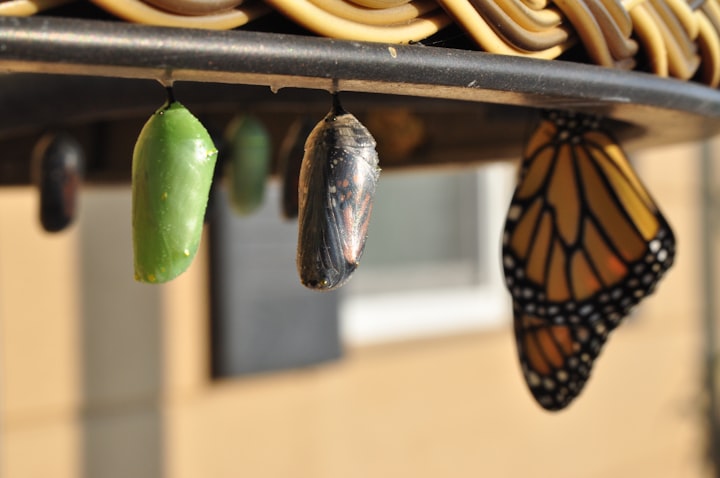Chronic Pain and Society
What is 100% or 5 by 5?

Are you five by five? - just what does that mean and where does it come from? If there are any content writers reading this on Vocal or have been working in the area of the military or in air traffic control (ATC) in their past employment(s) - then this would be a more than familiar phrase to hear this. And for those that don't recognize it, then, in short, it sometimes is used as a response when an aircraft or tower within the ATC is asking for a radio check - it represents a concise & clear confirmation that the transmission and the audible readability is clear and free from crackle or message disruption.
The primary '5' is to do with the signal strength, and the secondary '5' is about the signal clarity. The lower the numbers then the worse the strength and clarity.
Yes, I know what you are thinking here - 'why not just say loud and clear?' - It was initially established within the Northern Atlantic Treaty Organisation (NATO, article 5) back in 1946, after the second world war - it has stuck around within our society ever since.
Now you might be thinking, what has any of this got to do with chronic pain? - Everyone who has read my previous articles, and will know that I like to use music references ( and yes) chocolate; my favourite chocolate.
The term '5 by 5' has also made it into the field of television, and famously incorporated itself within the American television series,' Buffy the Vampire Slayer,' originally aired on British Television ( 1997 - 2003 & written by Whedon, J.)
(This always comes to mind even now. As detailed above this.)
Even these days, I have been suffering from chronic pain ever since my first car crash at the beginning of 2017. It is 2021 and I am still suffering from this - the clinic at the local hospital even now is using this adopted saying -
Well, I am currently a '2 by 2,' and have been this way for the past 2 years (using this analogy can be translated to chronic pain too) - whereby the first number represents the pain sensation strength and the second number represents how the pain sensation is currently affecting your daily ability to function because of it,
---------------------------------------------------------------------------------------
Chronic Pain (Neuropathic Pain) - Just what is it?
It stems from pain following an acute injury. Although not understood fully as yet, - the tissue damage caused by the initial injury does not heal 100%. As a result, the many nerve fibres throughout the human body stay alert and send chemical signals to our brain to fire, alerting to pain, causing the brain to understand there is damage that needs attention immediately - acting accordingly.
Do not get me wrong or misunderstand me here - all pain is real and does disrupt us in going about our daily lives.
---------------------------------------------------------------------------------------
Society's viewpoint:
Today, people suffering from chronic pain appear more prevalent within our society. A new study by the Centre for Disease Control (CDC) (no accurate dating found other than 2018 at source) revealed that 50 million Americans suffered from chronic pain. Within the United Kingdom, that figure was recorded at 28 million in 1996 (British Pain Society. 26th June 2016) under the heading of 'The Silent Epidemic - Chronic Pain in the UK.'
It is fair to say that as these figures suggest, chronic pain is widespread within the community at large. It's worth noting also that, at this time (2021) more up-to-date figures have not been published as yet.
Chronic pain is also listed as a 'hidden disability' too, which means that it is a disability that cannot be seen by others (in contrast to a broken leg) which can be seen by others. A considerable amount of society is far more open and willing to support those when they can physically see the difficulties that sufferers face daily, rather than support those when they cannot see it. Take for example the 'hidden disability' cards that were given to people suffering chronic pain & mental health issues, during the worldwide spread of Covid-19.
A well-known online site (and I will not name them here) was instrumental in alienating those faced with 'hidden disabilities,' by allowing these cards to be widely available to anyone who just wanted to get away with not having to wear a mask, when out & about. This directly led to shops disallowing entry to their stores - which I am certain you can imagine, caused an enormous amount of distress and agitation from chronic pain sufferers.
Activities of Daily Living (ADL):
Activities of Daily Living Skills were developed within the 1950s by (Geriatrician Sidney Katz)to support those healthcare workers to assess and measure changes in the physical function of patients being treated for physical & mental health conditions
It became known as the Katz Index (assessment criteria as below)
-- Dressing do you need support with this area?
-- Bathing what support is needed to manage this area?
-- Eating & Drinking can you do this on your own, or do you need support with feeding or need special cutlery or curved plates?
-- Mobility do you need someone to support or safeguard you from trips, falls, or need mobility aids (like zimmer frames, walking sticks, or wheelchair?)
-- Continence what about support here with dealing with this (continence aids or bar supports in the bathroom?)
-- Toileting as above (but would you need a hoist mechanism etc.,)
Remember though, this a basic run-through, the actual ADL assessment is very structured around this (a lot of chocolate bars were munched away at, sat in the nursing office filling these assessments in!)
I became aware of this when I started work as a registered nurse, after qualifying in 1992. Over the following years, it was condensed from an originally listed fourteen criteria - a real headache and time-consuming assessment phase to complete - when you were running a ward environment believe me! Now though, having just the six (with the other eight being facilitated within the newer six, (the Katz scale is far simpler to assess more accurately.)
I have suffered for a very long time now with chronic pain. To the point where I have had to leave my job as a registered mental health nurse earlier this year (2021.) I cannot walk further than a simple 20 metres without support from my wife and experiencing pain and needing to rest for approximately 10 minutes. I would like to suggest at this point for you to also read another of my articles as below:
Long Covid & the Equality Act 2010
and,
I receive disability through the UK social security department, for disability payments & through personal independence payments; both of whom are very supportive of how chronic pain can badly affect people. And like many other chronic pain sufferers, I am on constantly reviewable prescribed medications. And more recently have been prescribed medication to help with breakthrough pain during the night, resulting from badly affected sleep patterns.
But, education and understanding within society desperately need to be increased, so that more support can be enabled by them in this subject area.
Thanks to Vocal, I find my days now filled with enjoyable distractions now, because of my interest in writing being actively encouraged by their platform.
As the title image of this article suggests, chronic pain is like swimming in water every day.... constantly treading water so you do not sink under the waves...
---------------------------------------------------------------------------------------
Thank you for taking the time to read this. Please read and click the heart after reading. Anyone choosing to tip me, well, thank you so much for your generosity and kindness shown by this - hearts are great but tips help me succeed and do better but remember they are not obligatory.
More of my articles can be found at: https://vocal.media/authors/jonathan-townend
My email address for any comments please, to: [email protected]
About the Creator
Jonathan Townend
I love writing articles & fictional stories. They give me scope to express myself and free my mind. After working as a mental health nurse for 30 years, writing allows an effective emotional release, one which I hope you will join me on.






Comments
There are no comments for this story
Be the first to respond and start the conversation.